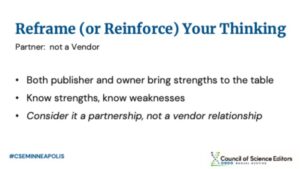MODERATOR:
Denise Kuo
JMIR Publications
SPEAKERS:
Adam Etkin
Origin Editorial LLC
Heather Goodell
American Heart Association
George Woodward
Oxford University Press
REPORTER:
Ruth Isaacson
Genetics Society of America
Building the Relationship
In the first half of this session, Heather Goodell of the American Heart Association and George Woodward of Oxford University Press presented tips for building and maintaining a successful relationship between the publisher and society or journal.
Both speakers emphasized the need to reframe the traditional view of a publisher and society/journal relationship (Figure). The most successful relationships often occur when both parties approach this relationship as a partnership and spend the time upfront working to understand the perspective of the other.

When entering a new partnership, the first question Woodward asks is “How do you measure success?” His goal is to gain perspective about what is important to the society or journal so that both parties can develop a contract with clear decision points and responsibilities.
Goodell and Woodward recommend that both parties embrace some vagueness when building the contract. For example, the contract might define that the publisher is responsible for providing funding for a submission system; however, it should not name the specific submission system. This allows the journal to switch submission systems as needed without renegotiating or amending the contract. The society or journal should also carefully assess its needs and areas of weakness. For example, if they require reports from the publisher outside of the standard reporting windows, they should include this in the contract. If they rely on the publisher for analyses they cannot do in-house, then this should be discussed upfront and listed as needed in the contract.
Contracts define trust and liability all while identifying expectations. If each party approaches the relationship as a partnership and talks about the principles that matter, they will be able to develop a contract that is flexible and able to evolve.
Goodell and Woodward also spoke about the importance of continual relationship building. Both parties should keep lines open regarding their goals, which may include publication output and quality level, research integrity, and the overall mission. Often, a breakdown of a publishing relationship is due to the society or journal not feeling listened to. For example, the society may feel pressured to grow for reasons that they do not understand or support. Discussing goals such as output (for both parties) can help to prevent such misunderstandings. Open dialogue can also help to dispel tension and bring about resolution over issues that are rarely binary. When both parties fail to understand each other’s culture and goals, this often leads to a dissolution of trust. When the trust is not there, or a society or journal feels trapped, it may be time for them to move on.
Moving On
Adam Etkin with Origin Editorial closed the session with an overview of the process involved in a new publisher search. Typically, societies/journals leave publishers for financial reasons or because they are dissatisfied with the partnership. Even if you are happy with your current publisher, it can be a useful exercise to begin a conversation with your current publisher before ruling out considering new partnerships. As a renewal period draws near, the act of evaluating a current partnership can help the society or journal determine several things, including whether the publisher is still committed, there are potential contract updates, or there are issues such as staffing changes, acquisitions, etc.
The evaluation process should begin at least 18 months in advance of the contract termination date; thus, societies or journals need to be aware of their termination clauses and obligations. Ideally a society or journal staffer has both maintained oversight of the contract and monitored for completion of work outlined in the contract. If not, or the society or journal feels that it is beneficial, then a consultant should be brought in.
First, the society or journal should initiate a conversation with the publisher. The society or journal should go into the conversation prepared to talk about what their strengths are, what they bring to the table, if they are happy, or if not, why they are not. If unhappy, Etkin suggests that the society asks tough questions of itself—sometimes something that feels like a critical issue will not change with a publisher switch (e.g., production being outsourced).
For societies or journals that plan to issue a request for proposal (RFP), they should also evaluate the risk and resources required. There should be a backup plan for if no one responds and one should be aware that this RFP may create unnecessary tension with the current publisher. All three speakers cautioned against issuing an RFP every 5 years, given the amount of time and resources involved.
Should the RFP result in a successful transfer to a new publisher, Etkin shared some items to consider as the process begins. Thanks to the NISO Transfer Code of Practice, the process is now simpler than in the past, but each society and journal should still have dedicated staff monitoring the transition process and schedule. Submission and peer review system shifts are the most labor-intensive process of a transition, even if within the same submission system. There should be plans in place for a 6–12 month submission system transition period, as well as training for staff and editors. The society will also need to ensure that subscriber and member lists transfer, and that members continue to have access and receive details on the transition. Other items to consider during the transition period include rights integrations, DOI changes, production changes and testing, etc. Going into the transition with a clear plan, designated responsible parties, and consistent messaging to your community will help to ensure success.
